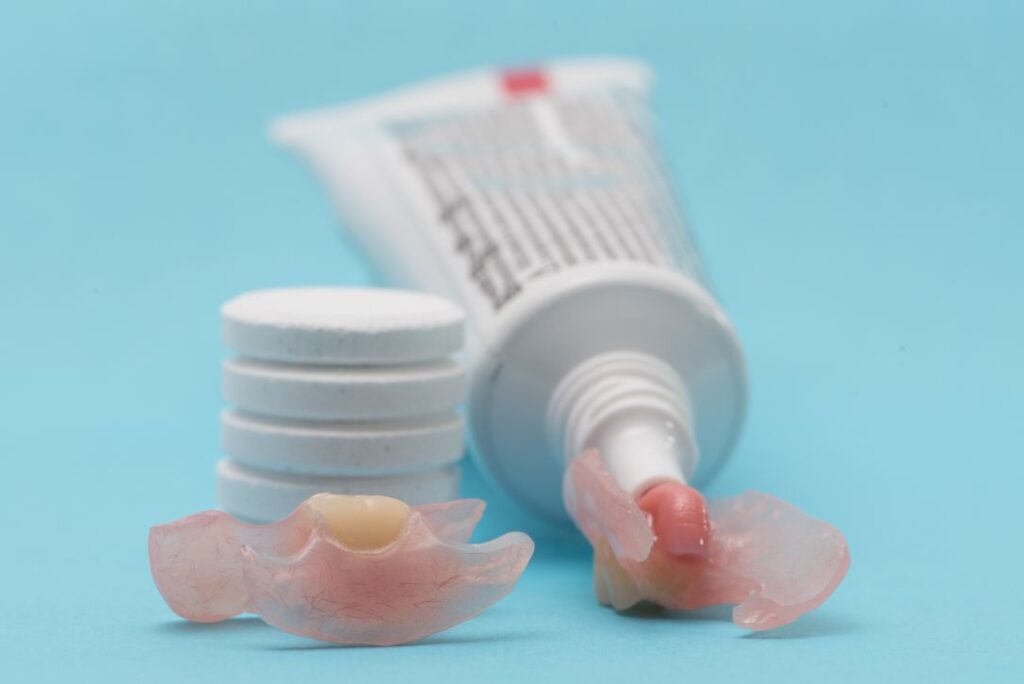
Your dentures were designed to fit your individual mouth comfortably and securely, but over time your gums, arches, and the prosthetics themselves can change. Unfortunately, even the slightest difference in your mouth can make it difficult for them to stay in place. Thankfully, for those times there is a product called denture adhesive that can help keep your false teeth on until you can repair or replace them. Here’s what you need to know about some of the most popular varieties.
What Type of Denture Adhesive Should I Choose?
When it comes to which type of denture adhesive to choose, the great news is that it’s mainly a matter of personal preference. Though they are all slightly different, each works equally well.
Denture Adhesive Powder
- After cleaning your dentures well, leave them wet and set them down somewhere safe.
- Spray the denture adhesive powder lightly and evenly on all the surfaces that will make contact with your gums and the roof of your mouth.
- Moisten your mouth with water.
- Shake excess adhesive powder off the prosthetic.
- Place your denture in your mouth and bite down on it to hold it into place.
Denture Adhesive Strips
- Completely clean and dry your denture.
- With clean, dry hands peel the adhesive strips from their packaging and then wet each strip with water.
- Attach one strip at a time to your prosthetic as shown in the adhesive instructions. Be careful to avoid the edges of your denture, and don’t overlap the strips. Cut or tear them into shape as needed.
- Rinse your mouth with water.
- Press the denture in place in your mouth, holding it firmly and biting down to obtain a good hold.
Denture Adhesive Cream
- After cleaning and drying your dentures, apply adhesive cream directly to the inside of the prosthetic using short strips. Make sure you don’t get any on the edges, and be careful not to put too much so it’s not oozing out from the sides when you put your false teeth in.
- Rinse your mouth with water.
- Pressing your denture into place, hold it firmly for several seconds. Then, bite down with it to hold it in place.
Removing Adhesive from Your Dentures
Once you’ve finished wearing your dentures for the day, swish some warm water in your mouth and gently pull them out. Place them somewhere safe, and then using a soft-bristled toothbrush, gently scrub the remaining adhesive from your gums with toothpaste.
After cleaning your mouth, use a different soft-bristled toothbrush and scrub your entire denture with either mild hand soap or a denture cleanser. Be sure to floss between each tooth and rinse your prosthetic well before gently placing it in a glass of water or soak until it’s time to wear them again.
Remember, if you do notice your dentures no longer fit correctly, adhesives can help, however they should never be used as a long-term solution. Loose or uncomfortable dentures are a sign that it could be time for a repair or replacement, so schedule an appointment with your dentist at your earliest convenience.
About Our Practice
Dr. James K. Kramer and Dr. Paul Kramer are the dynamic father-son duo who have been providing high quality oral health care to Selbyville patients for decades. Whether you have a full set of natural teeth, or your smile has been beautifully restored with the help of dentures, Kramer Dental offers a wide range of treatments to help keep you looking and feeling your best. To schedule an appointment for dentures, please visit our website or call us today at 302-436-5133.
